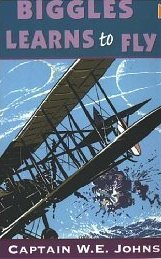What do you think?
Rate this book


315 pages, Kindle Edition
First published March 1, 1935
There was nothing remarkable, or even martial about his physique; on the contrary, he was slim, rather below average height, and delicate looking. A wisp of fair hair protruded from one side of his rakishly tilted RFC cap; his eyes, now sparkling with pleasurable anticipation, were what is usually called hazel. His features were finely cut, but the squareness of his chin and the firm line of his mouth revealed a certain doggedness, a tenacity of purpose, that denied any suggestion of weakness. Only his hands were small and white, and might have been those of a girl.’ (Pp9-10)The raw recruit joins his fellow young pilots and learns how to survive, though barely. After a week of training in the ‘Rumpity,’ the quaintly named Maurice Farman Shorthorn, Biggles makes his first solo flight and manages to almost stall, almost crash and get completely lost. Three days later he’s off to the school of fighting and three days after that he’s posted to France with 15 hours flying time.
It was his first real lesson in the art of air combat. His pride suffered when he thought of the way the Hun ‘had made rings round him,’ and he was not quite as confident of himself as he had been, yet he knew that the experience was worth all the anxiety it had caused him. (p126)The duel resumes later and Biggles manages to remove the enemy’s propeller with his dangling observational aerial, when he did a sudden loop. Only in a Biggles story.